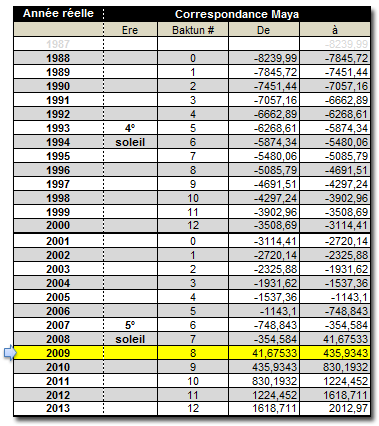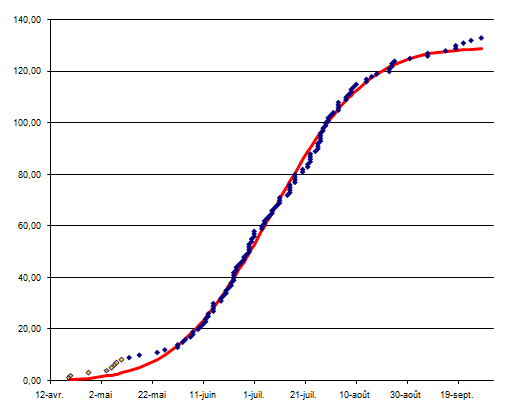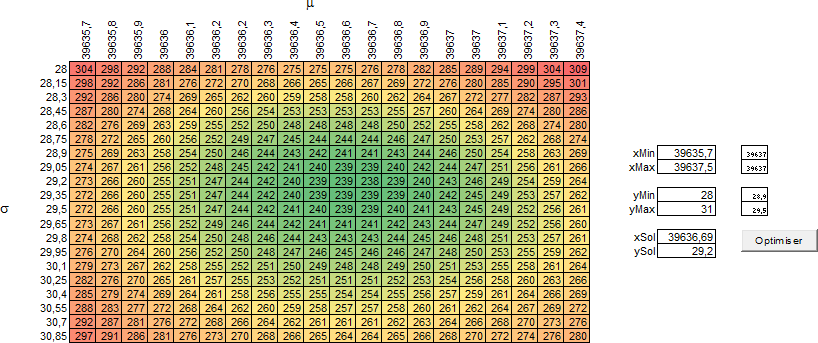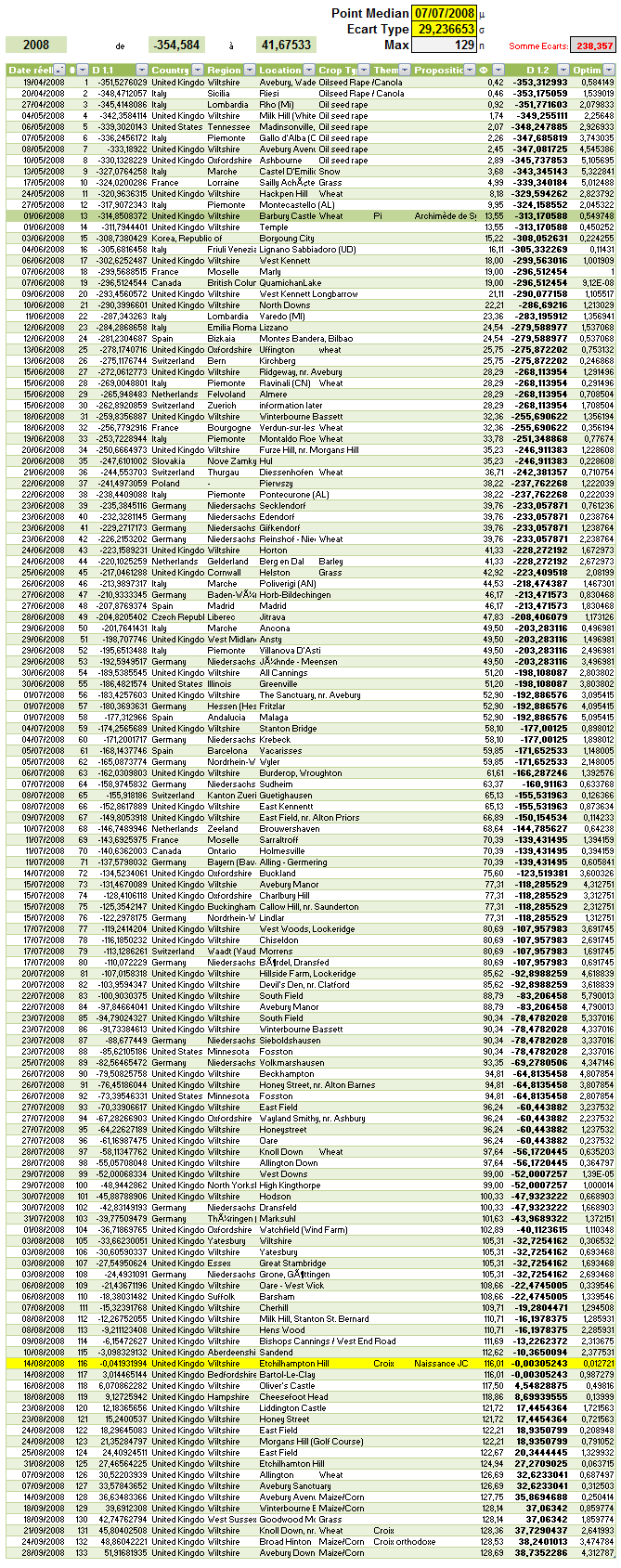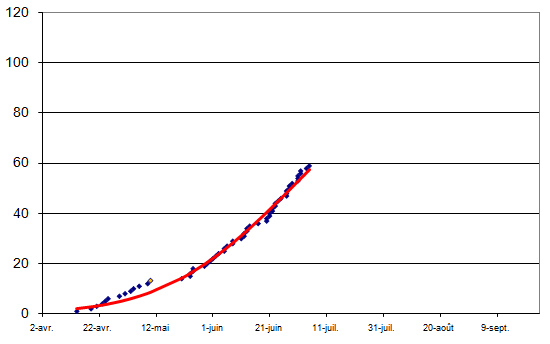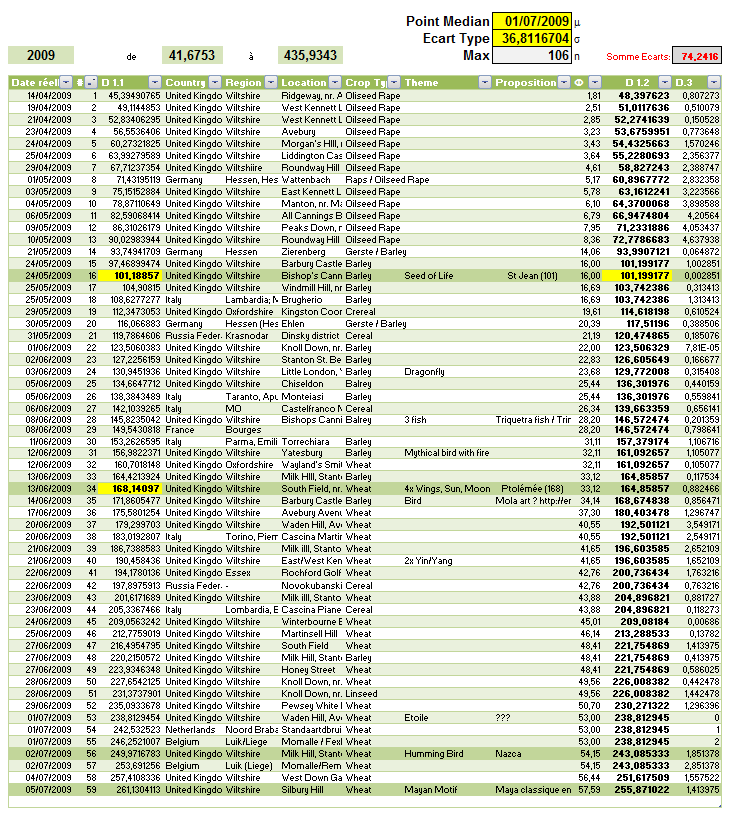Difference between revisions of "Methodology for calculating past dates associated with Crops Circles"
| Line 58: | Line 58: | ||
|} | |} | ||
| − | + | The calculation table used (and obtained) is as follows, the column named "D1.1" corresponding to the old method used (however we will not find the same figures, because I have updated them here) and "D1.2 which is the one proposed here (noted in bold). The precision for the symbol of the cross associated with the birth of Jesus Christ is incredible!<br> | |
{| | {| | ||
| − | |[[Image:Chronologie_Crop_Circle_2008.png|frame|''' | + | |[[Image:Chronologie_Crop_Circle_2008.png|frame|'''Year 2008'''. Dataset used. Note the -314 for pi :) ]]<br> |
|} | |} | ||
Dans le détail :<br> | Dans le détail :<br> | ||
| − | * ''' | + | * '''The column labeled « φ »''' gives the values for the distribution function. (drawn in red). It is calculated as follows in Excel: |
| − | + | φ = ''n''*1/2*(1+SI(([Date réelle]-''μ'')/(''σ''*RACINE(2))>0;ERF(([Date réelle]-''μ'')/(''σ''*RACINE(2)));ERF(ABS(([Date réelle]-''μ'')/(''σ'' *RACINE(2)));0))) | |
| − | + | Where ''n'' is the "maximum/virtual" number of crop circles that this function will represent. Not to be confused with the “maximum/actual” number of crop circles produced in the year. Indeed, this function provides an idealized vision of the evolution which precisely must eliminate abnormal productions/deviations. This value is adjusted approximately and does not matter as we will immediately see. | |
| − | * ''' | + | * '''The column labeled « D1.2 »''' provides the actual calculation of the past date associated with the crop circle. The variable n used previously disappears, since we determine our date as a ratio, still using the same method, but using the distribution function: |
| − | = ( | + | = (φ/''n'')*[Duration of a Baktun] + [Date associated with the start of the season] |
| − | + | with 394.2752308 for the duration of a Baktun and -354.584 for the start date of the 2008 season. We obtain the following parameters: | |
| − | + | ''μ'' = 07/07/2008 15:27:34 | |
| − | + | ''σ'' = 29.23664701 | |
| − | + | ''n'' = 129 | |
<div style="margin: 0; margin-right:6px; border: 1px solid #dfdfdf; padding: 0 1em 1em 1em; background-color:#dfdfff; align:right;"> | <div style="margin: 0; margin-right:6px; border: 1px solid #dfdfdf; padding: 0 1em 1em 1em; background-color:#dfdfff; align:right;"> | ||
| − | ==== | + | ====Notes about the maximum number of crop circles (variable ''n'')==== |
| − | [1] ''n'' | + | [1] ''n'' is a theoretical, '''not real''', value associated with the distribution function. Precisely it is the MAXimum (and idealized) number of crop circles produced in the year. Deviations and other anomalies mean that this number is not necessarily the real (= observable) number |
| − | [2] | + | [2] on the method of establishment by successive approximations of ''σ'' et ''μ'' : even though the variable ''n'' does not intervene directly in the calculation of dates, it remains implicitly hidden. Indeed, it is always necessary to make a hypothesis on the MAXimum (and theoretical) ''number n'' of crop circles in order to be able to calculate the error rate of the numerical model compared to the observed reality and thus to select the best pair of solutions {''σ'', ''μ''}. It is therefore appropriate to seek this best pair for all of the n "reasonably" possible (for example, between 0 and 300...). |
| − | |||
| − | ==== | + | ==== Chronology for the year 2009 (stopped at 09/07/09)==== |
| − | + | Here is the same exercise for the year 2009 which is beginning, to be taken with reservations given an "open" data set. | |
{| | {| | ||
| − | |[[Image:2009_Fonction_de_repartition_Crop-Circles.png|frame|''' | + | |[[Image:2009_Fonction_de_repartition_Crop-Circles.png|frame|'''Year 2009'''. Provisional distribution function of crop circles (2009-07-09)]] |
|} | |} | ||
| − | + | <br> | |
{| | {| | ||
| − | |[[Image:2009_Chronologie_Crop_Circles.png|frame| | + | |[[Image:2009_Chronologie_Crop_Circles.png|frame|Dataset used (2009-07-09)]]<br> |
|} | |} | ||
| − | + | The 2009 season starts at +41.67533. We get the following (provisional) parameters: | |
| − | + | ''μ'' = 01/07/2009 00:00:01 | |
| − | + | ''σ'' = 36.8115648 | |
| − | + | ''n'' = 106 | |
| − | + | Of course, these values will need to be consolidated as new data is received. | |
| − | == | + | ==Results: proposed correlations== |
| − | === | + | ===Year 2009=== |
| − | + | The results using the two methods are given below {D1.1, D1.2}. That is to say, using the rank of the crop circle on the one hand and using the distribution function on the other hand. Curiously, the first seems to work just as well (or even better?). | |
| − | + | {| cellpadding="4" cellspacing="0" align="left" style="margin: 0; margin-right:0px; border: 1px solid #cccccc; padding: 0 0 0 0; background-color:#eeeeee; align :left; valid=top;" | |
| − | |||
| − | {| cellpadding="4" cellspacing="0" align="left" style="margin: 0; margin-right:0px; border: 1px solid #cccccc; padding: 0 0 0 0; background-color:#eeeeee; align:left; | ||
!bgcolor="#bbbbbb"|'''Crop-Circle''' | !bgcolor="#bbbbbb"|'''Crop-Circle''' | ||
| − | !bgcolor="#bbbbbb"|''' | + | !bgcolor="#bbbbbb"|'''Theme''' |
| − | !bgcolor="#bbbbbb"|''' | + | !bgcolor="#bbbbbb"|'''Calculated date(s) {d1.1, d1.2}''' |
| − | !bgcolor="#bbbbbb"|'''Prop. - | + | !bgcolor="#bbbbbb"|'''Prop. - detail''' |
| − | !bgcolor="#bbbbbb"|'''Prop. - date | + | !bgcolor="#bbbbbb"|'''Prop. - linked date(s)''' |
|- | |- | ||
|[[image:Crop-circle_200900524_St_Jean.jpg]] | |[[image:Crop-circle_200900524_St_Jean.jpg]] | ||
| − | | | + | |Double Seed of Life. |
|{+101, +101} | |{+101, +101} | ||
| − | | | + | |Symbolic associated with the location of the tomb of St. John (Apostle). 7 days of genesis: see [[Crop_circles:_impossibles_scénarios#1._La_.22G.C3.A9om.C3.A9trie_sacr.C3.A9e.22_.28Sacred_Geometry.29|Sacred geometry]] and [[Synchronicity_and_predictions|Synchronicity and predictions with St John the Apostle]] |
| − | | | + | |Death in +101 ([http://fr.wikipedia.org/wiki/Jean_(ap%C3%B4tre) fr]) or +100 ([http://en.wikipedia.org/wiki/John_the_Apostle en] ) |
|- | |- | ||
|bgcolor="#cccccc"|[[image:Crop-circle_20090613_ptolemee.jpg]] | |bgcolor="#cccccc"|[[image:Crop-circle_20090613_ptolemee.jpg]] | ||
| − | |bgcolor="#cccccc"| | + | |bgcolor="#cccccc"|Geocentric system. |
|bgcolor="#cccccc"|{+168, +164} | |bgcolor="#cccccc"|{+168, +164} | ||
| − | |bgcolor="#cccccc"| | + | |bgcolor="#cccccc"|Ptolemy's Improved Geocentric System. A central element (probably the earth) eclipses the Moon. Around the moon we observe the sun. |
| − | |bgcolor="#cccccc"| | + | |bgcolor="#cccccc"|Death around +168 ([http://fr.wikipedia.org/wiki/Ptol%C3%A9m%C3%A9e fr]) |
|- | |- | ||
|[[Image:Crop-circle_20090704_Nazca.jpg]] | |[[Image:Crop-circle_20090704_Nazca.jpg]] | ||
|Colibri (Hummingbird) | |Colibri (Hummingbird) | ||
|{+249, +243} | |{+249, +243} | ||
| − | | | + | |Nazca Geoglyph. Incidentally, see the [http://www.u-sphere.com/index.php?title=Lignes_de_Nazca electroseismic theory] on u-sphere about the Nazca lines. |
| − | | | + | |Between -300 and +800 ([http://fr.wikipedia.org/wiki/G%C3%A9oglyphes_de_Nazca fr]) or -200 and +700 ([http://en.wikipedia.org/wiki/Nazca_Lines in]) |
|- | |- | ||
|bgcolor="#cccccc"|[[Image:Crop-circle_20090705_Maya.jpg]] | |bgcolor="#cccccc"|[[Image:Crop-circle_20090705_Maya.jpg]] | ||
| − | |bgcolor="#cccccc"| | + | |bgcolor="#cccccc"|Mayan pattern |
|bgcolor="#cccccc"|{+261, +255} | |bgcolor="#cccccc"|{+261, +255} | ||
| − | |bgcolor="#cccccc"| | + | |bgcolor="#cccccc"|Perhaps related to Quetzalcóatl (or Tezcatlipoca-white, feathered serpent), mainly venerated in the Mesoamerican area. In this hypothesis, it could correspond to the apogee of the city of [http://fr.wikipedia.org/wiki/Teotihuacan Teotihuacán] (in Aztec mythology, the place where the gods met to create the sixth sun, that of our era) and the construction of the Pyramid of the Feathered Serpent (Miccaotli phase: 150-250 AD). Classic Maya period in Central America. On a similar theme see the [[Crop_Circles:040802_Silbury_Hill|"Doomsday Crop Circle"]]. |
|bgcolor="#cccccc"|(150-250) ? | |bgcolor="#cccccc"|(150-250) ? | ||
|} | |} | ||
| + | === Year 2008 === | ||
| − | + | {| cellpadding="4" cellspacing="0" align="left" style="margin: 0; margin-right:0px; border: 1px solid #cccccc; padding: 0 0 0 0; background-color:#eeeeee; align :left; valid=top;" | |
| − | |||
| − | |||
| − | {| cellpadding="4" cellspacing="0" align="left" style="margin: 0; margin-right:0px; border: 1px solid #cccccc; padding: 0 0 0 0; background-color:#eeeeee; align:left; | ||
!bgcolor="#bbbbbb"|'''Crop-Circle''' | !bgcolor="#bbbbbb"|'''Crop-Circle''' | ||
| − | !bgcolor="#bbbbbb"|''' | + | !bgcolor="#bbbbbb"|'''Theme''' |
| − | !bgcolor="#bbbbbb"|''' | + | !bgcolor="#bbbbbb"|'''Calculated date(s) {d1.1, d1.2}''' |
| − | !bgcolor="#bbbbbb"|'''Prop. - | + | !bgcolor="#bbbbbb"|'''Prop. - detail''' |
| − | !bgcolor="#bbbbbb"|'''Prop. - date | + | !bgcolor="#bbbbbb"|'''Prop. - linked date(s)''' |
|- | |- | ||
|[[image:Crop-circle_20080814_jesus-christ.jpg]] | |[[image:Crop-circle_20080814_jesus-christ.jpg]] | ||
| − | | | + | |Cross |
|{0, 0} (+1) | |{0, 0} (+1) | ||
| − | | | + | |Birth of Jesus Christ. See [[Etchilhampton_Hill%2C_Wiltshire%2C_Crop_circle_in_the_shape_of_the_cross|Etchilhampton Hill, Crop-circle in the shape of a cross]]. |
| − | | | + | |Year 1 (year 0 does not exist) |
|- | |- | ||
|bgcolor="#cccccc"|[[image:Crop-circle_20080601_Pi.jpg]] | |bgcolor="#cccccc"|[[image:Crop-circle_20080601_Pi.jpg]] | ||
|bgcolor="#cccccc"|Pi | |bgcolor="#cccccc"|Pi | ||
|bgcolor="#cccccc"|{-314, -313} | |bgcolor="#cccccc"|{-314, -313} | ||
| − | |bgcolor="#cccccc"| | + | |bgcolor="#cccccc"|Related to Archimedes of Siracusa? Indeed, Pi is also called [[Constant_d%27Archim%C3%A8de|Constant of Archimedes]]. |
| − | |bgcolor="#cccccc"| | + | |bgcolor="#cccccc"|Maybe the solution is -314.1592654? :) Archimedes lived between -287 and -212. |
|} | |} | ||
| − | === | + | === Year 2007 === |
| − | {| cellpadding="4" cellspacing="0" width="100%" align="left" style="margin: 0; margin-right:0px; border: 1px solid #cccccc; padding: 0 0 0 0; background-color:#eeeeee; align:left; valign=top;" | + | {| cellpadding="4" cellspacing="0" width="100%" align="left" style="margin: 0; margin-right: 0px; border: 1px solid #cccccc; padding: 0 0 0 0; background- color:#eeeeee; align:left; valign=top;" |
!bgcolor="#bbbbbb"|'''Crop-Circle''' | !bgcolor="#bbbbbb"|'''Crop-Circle''' | ||
| − | !bgcolor="#bbbbbb"|''' | + | !bgcolor="#bbbbbb"|'''Theme''' |
| − | !bgcolor="#bbbbbb"|''' | + | !bgcolor="#bbbbbb"|'''Calculated date(s) {d1.1, d1.2}''' |
| − | !bgcolor="#bbbbbb"|'''Prop. - | + | !bgcolor="#bbbbbb"|'''Prop. - detail''' |
| − | !bgcolor="#bbbbbb"|'''Prop. - date | + | !bgcolor="#bbbbbb"|'''Prop. - linked date(s)''' |
|- | |- | ||
|[[image:Crop-circle_20070707_Taijitu.jpg]] | |[[image:Crop-circle_20070707_Taijitu.jpg]] | ||
| − | |Taijitu + | + | |Taijitu + Yi-King "hexagrams" |
|{-492, -494} | |{-492, -494} | ||
| − | |Lao | + | |Lao Tzu and the emergence of Taoism. |
| − | | | + | |Born in -604 would have died in -479. |
|- | |- | ||
|bgcolor="#cccccc"| | |bgcolor="#cccccc"| | ||
| Line 192: | Line 187: | ||
|} | |} | ||
| − | === | + | ===Earlier years (more approximate chronology)=== |
| − | + | The previous detailed elements are to be related to this chronology: | |
{| | {| | ||
| − | |[[image:CropProgression2008b.png|frame| | + | |[[image:CropProgression2008b.png|frame|It is possible to speak of [[Crop_Circles_and_protohistory_humane#Corr.C3.A9lations_.21|chronological convergence]] since the scenario produced by the crop circles will reach the present time in 2012/2013. Two remarkable points here: <br> 1/ the reminders between the symbols generated by the crop circles and the calendar of José Arguelles (bottom) (hence [[Crop_circles:_impossibles_scénarios|the JA hypothesis]]), <br > 2/ '''The convergence of crop circles with the present time is at the end of 2013 and not at the end of 2012 (who would have said it?)''']] |
|} | |} | ||
| − | + | But also, with all the symbols that can be linked to a spiritual and/or religious meaning and that can be "relatively" datable (still to be done): | |
| − | ==== | + | ==== Historical/Religious/Spiritual crop circles ==== |
| − | <iframe src="data/grid.php?id_crop_type=2& | + | <iframe src="data/grid.php?id_crop_type=2&width=9" width="904" height="500" frameborder="0"></iframe> |
| − | <br>''note: | + | <br>''note: the green coloring of some of the thumbnails above is due to the superposition of the blue and yellow color (two types associated...)'' |
| − | + | See the types of crop circles offered on [[U-Sphere_CropDB|this page]]. | |
| − | == Conclusion == | + | ==Conclusion== |
| − | + | In the end, the past date of a Crop Circle is based on the following parameters: | |
| − | * | + | * The date of appearance of the Crop-Circle, |
| − | * | + | * The spread of the season (or standard deviation), ''σ'', |
| − | * | + | * The midpoint of the season, ''μ''. |
| − | + | And, as a fixed parameter, we have the duration of the Baktun. | |
| − | + | What quite incredible, when we optimize the values for ''μ'' and ''σ'' for the year 2008, the precision concerning the dating of the event corresponding to the birth of Jesus Christ increases in a correlated way ! After 7 iterations (approximation) the accuracy reaches year 0 at 3.10^-3 (~ accurate to within 1 day in the past). Beyond that, it stagnates. | |
| − | + | I wonder: how was a solution for the birth of JC made possible within 3.10-3?? At this time of year, each day is equivalent to 2.43 years elapsed. This means that the ''μ'' and ''σ'' parameters were precisely anticipated by the crop-circle makers. | |
| − | ''' | + | '''As incredible as it may seem, I lean towards this solution, because at this point, the same phenomenon is observed in 2009: the variable ''μ'' is centered on July 1, 2008 at 0 hours, 0 minutes and 1 second!'''. |
| − | + | There is also a relationship between ''μ'', ''σ'' and the rate of maturation of the fields/crops which changes every year. And that was well taken into account. From a certain point of view, if this theory is valid, those who build the crop circles, ''knew'' that it was on that day that the cross had to be made, and that in addition, given the parameters retained, this day would coincide to within 3.10^-3 (at least)… | |
| − | == | + | ==References == |
| − | + | About the establishment of the chronology (in order of seniority of the articles):''' | |
| − | * (1) [[Crop Circles | + | * (1) [[Crop Circles and Human Protohistory]]. Foundation of the hypothesis: protohistory, until the 2008 season, |
| − | * (2) [[ | + | * (2) [[Chronology of Crops Circles]], details. |
| − | * (3) [[Crop_circles:_impossibles_sc%C3%A9narios| | + | * (3) [[Crop_circles:_impossibles_sc%C3%A9narios|Impossible scenarios]]. Generic scenario and the José Argüelles hypothesis. |
Revision as of 21:25, 9 June 2022
Contents
Methodology: a reconciliation of the past date of the crop circles to within 10^-3 years?
Quite a provocative title, because this advanced precision is only verified for one day: that of the "birth" of Jesus Christ! (see below). However, the result is sufficiently surprising to deserve to be underlined. The other results remain very good.
Basically, what led me to write this article is the methodology for calculating dates for crop-circles proposed in these pages, which although apparently quite satisfactory, still poses a problem of precision linked the reliability of the sources. Can we improve this point? Possibly, yes.
As a reminder, I associate with each crop-circle presenting a recognizable historical symbol, a precise date in the history of humanity, function:
1/ of the year in which this crop circle occurred, ,
It has been proposed that each passing year sees the advancement of a baktun. See the article titled timeline elements on crop circles. Which can be summarized by the following table:
2/ of the order number of this crop-circle in the year,
3/ of the total number of crop circles taking place in that year.
Points 2/ and 3/ allow the time elapsed to be calculated in proportion to the progress in the season. Which means, *roughly* that the first crop-circle for the year 2009 should be associated with +41 ap. JC and the last at +435 AD. JC.
Assessing the ratio to get the advancement in the timeline being one method, another would be to base it on the start and end of the season. I had also compared the two methods in a previous article. However, a certain number of cases among these crop circles are "false" (see opposite): this number can be important, how to manage this "noise" ? Because, although the variables 2. and 3. compensate each other, which makes a certain noise acceptable (especially if it is homogeneous), this nevertheless introduces punctual deviations in the date calculations (it is precisely these deviations which can observed in the last column of the table given below).
.

How to make the method more reliable?
Essentially, by trying to make it independent of the order number and the total (observable) number of crop circles (cf. remark [2] below about the maximum number of crop circles).
Basically, we must continue to base ourselves on the date of advancement in the season. Nevertheless, as the beginning of the season and the end of the season cannot be known with precision, I propose what had already been noted, that is to say, to qualify a season according to the nature of a distribution function whose the parameters will be calculated. This will have the advantage of eliminating the background noise linked to "false" crop-circles and of allowing a date in the past to be associated with any dated event. Let's see how to achieve this:
It is recalled that the distribution function used is the integral of a reduced centered normal law, ie:
![]()
Which is also written:

erf being a special function, called Gaussian Error Function. This function has been implemented in Excel, which frees us from the tedious use of an approximation table or the development of a Taylor series…
The associated variables are as follows:
- μ: the midpoint or mid-season date, (in practice a date number in “billou” format and which is a real number for MS Office),
- σ: standard deviation (in days)
Timeline for the year 2008
The test can be carried out on the year 2008 since it provides us with one of the crop circles that can be dated most precisely! The one symbolically representing the year 0 and associated with the birth of Jesus Christ (even if this was indeed not the case, the symbol takes precedence). To calculate the values of Mu.pngand of Sigma.png, I start from approximate realistic values ( μ= July 8, 2008 and σ = 30 days ), then try to minimize the sum of the differences between the indices given by the distribution function and those given by the crop circles, and according to their date of appearance (“optimum” column in the table below).
Visually, the red curve representing the distribution function snaps onto the points representing the sequence of crop circles.
The calculation table used (and obtained) is as follows, the column named "D1.1" corresponding to the old method used (however we will not find the same figures, because I have updated them here) and "D1.2 which is the one proposed here (noted in bold). The precision for the symbol of the cross associated with the birth of Jesus Christ is incredible!
Dans le détail :
- The column labeled « φ » gives the values for the distribution function. (drawn in red). It is calculated as follows in Excel:
φ = n*1/2*(1+SI(([Date réelle]-μ)/(σ*RACINE(2))>0;ERF(([Date réelle]-μ)/(σ*RACINE(2)));ERF(ABS(([Date réelle]-μ)/(σ *RACINE(2)));0)))
Where n is the "maximum/virtual" number of crop circles that this function will represent. Not to be confused with the “maximum/actual” number of crop circles produced in the year. Indeed, this function provides an idealized vision of the evolution which precisely must eliminate abnormal productions/deviations. This value is adjusted approximately and does not matter as we will immediately see.
- The column labeled « D1.2 » provides the actual calculation of the past date associated with the crop circle. The variable n used previously disappears, since we determine our date as a ratio, still using the same method, but using the distribution function:
= (φ/n)*[Duration of a Baktun] + [Date associated with the start of the season]
with 394.2752308 for the duration of a Baktun and -354.584 for the start date of the 2008 season. We obtain the following parameters:
μ = 07/07/2008 15:27:34 σ = 29.23664701 n = 129
Notes about the maximum number of crop circles (variable n)
[1] n is a theoretical, not real, value associated with the distribution function. Precisely it is the MAXimum (and idealized) number of crop circles produced in the year. Deviations and other anomalies mean that this number is not necessarily the real (= observable) number
[2] on the method of establishment by successive approximations of σ et μ : even though the variable n does not intervene directly in the calculation of dates, it remains implicitly hidden. Indeed, it is always necessary to make a hypothesis on the MAXimum (and theoretical) number n of crop circles in order to be able to calculate the error rate of the numerical model compared to the observed reality and thus to select the best pair of solutions {σ, μ}. It is therefore appropriate to seek this best pair for all of the n "reasonably" possible (for example, between 0 and 300...).
Chronology for the year 2009 (stopped at 09/07/09)
Here is the same exercise for the year 2009 which is beginning, to be taken with reservations given an "open" data set.
The 2009 season starts at +41.67533. We get the following (provisional) parameters:
μ = 01/07/2009 00:00:01 σ = 36.8115648 n = 106
Of course, these values will need to be consolidated as new data is received.
Results: proposed correlations
Year 2009
The results using the two methods are given below {D1.1, D1.2}. That is to say, using the rank of the crop circle on the one hand and using the distribution function on the other hand. Curiously, the first seems to work just as well (or even better?).
| Crop-Circle | Theme | Calculated date(s) {d1.1, d1.2} | Prop. - detail | Prop. - linked date(s) |
|---|---|---|---|---|

|
Double Seed of Life. | {+101, +101} | Symbolic associated with the location of the tomb of St. John (Apostle). 7 days of genesis: see Sacred geometry and Synchronicity and predictions with St John the Apostle | Death in +101 (fr) or +100 (en ) |

|
Geocentric system. | {+168, +164} | Ptolemy's Improved Geocentric System. A central element (probably the earth) eclipses the Moon. Around the moon we observe the sun. | Death around +168 (fr) |

|
Colibri (Hummingbird) | {+249, +243} | Nazca Geoglyph. Incidentally, see the electroseismic theory on u-sphere about the Nazca lines. | Between -300 and +800 (fr) or -200 and +700 (in) |

|
Mayan pattern | {+261, +255} | Perhaps related to Quetzalcóatl (or Tezcatlipoca-white, feathered serpent), mainly venerated in the Mesoamerican area. In this hypothesis, it could correspond to the apogee of the city of Teotihuacán (in Aztec mythology, the place where the gods met to create the sixth sun, that of our era) and the construction of the Pyramid of the Feathered Serpent (Miccaotli phase: 150-250 AD). Classic Maya period in Central America. On a similar theme see the "Doomsday Crop Circle". | (150-250) ? |
Year 2008
| Crop-Circle | Theme | Calculated date(s) {d1.1, d1.2} | Prop. - detail | Prop. - linked date(s) |
|---|---|---|---|---|

|
Cross | {0, 0} (+1) | Birth of Jesus Christ. See Etchilhampton Hill, Crop-circle in the shape of a cross. | Year 1 (year 0 does not exist) |

|
Pi | {-314, -313} | Related to Archimedes of Siracusa? Indeed, Pi is also called Constant of Archimedes. | Maybe the solution is -314.1592654? :) Archimedes lived between -287 and -212. |
Year 2007
Earlier years (more approximate chronology)
The previous detailed elements are to be related to this chronology:
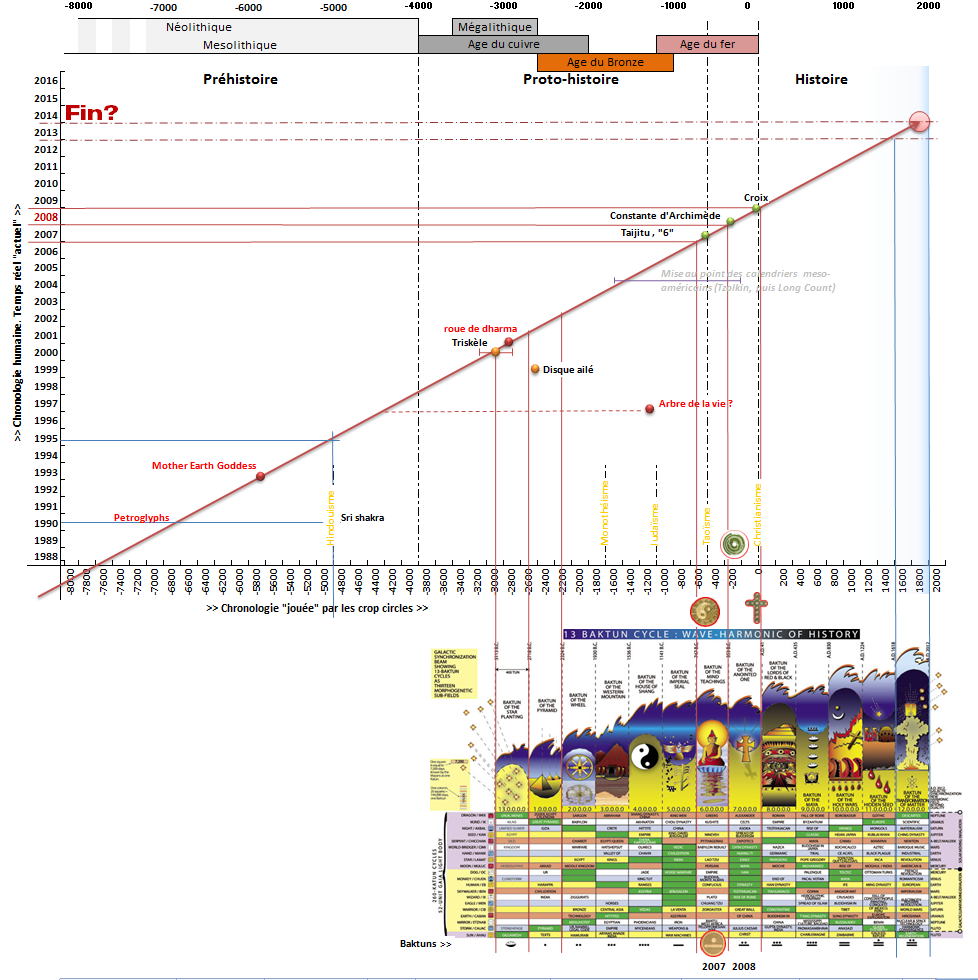 It is possible to speak of chronological convergence since the scenario produced by the crop circles will reach the present time in 2012/2013. Two remarkable points here: 1/ the reminders between the symbols generated by the crop circles and the calendar of José Arguelles (bottom) (hence the JA hypothesis), 2/ The convergence of crop circles with the present time is at the end of 2013 and not at the end of 2012 (who would have said it?) |
But also, with all the symbols that can be linked to a spiritual and/or religious meaning and that can be "relatively" datable (still to be done):
Historical/Religious/Spiritual crop circles
note: the green coloring of some of the thumbnails above is due to the superposition of the blue and yellow color (two types associated...)
See the types of crop circles offered on this page.
Conclusion
In the end, the past date of a Crop Circle is based on the following parameters:
- The date of appearance of the Crop-Circle,
- The spread of the season (or standard deviation), σ,
- The midpoint of the season, μ.
And, as a fixed parameter, we have the duration of the Baktun.
What quite incredible, when we optimize the values for μ and σ for the year 2008, the precision concerning the dating of the event corresponding to the birth of Jesus Christ increases in a correlated way ! After 7 iterations (approximation) the accuracy reaches year 0 at 3.10^-3 (~ accurate to within 1 day in the past). Beyond that, it stagnates.
I wonder: how was a solution for the birth of JC made possible within 3.10-3?? At this time of year, each day is equivalent to 2.43 years elapsed. This means that the μ and σ parameters were precisely anticipated by the crop-circle makers. As incredible as it may seem, I lean towards this solution, because at this point, the same phenomenon is observed in 2009: the variable μ is centered on July 1, 2008 at 0 hours, 0 minutes and 1 second!.
There is also a relationship between μ, σ and the rate of maturation of the fields/crops which changes every year. And that was well taken into account. From a certain point of view, if this theory is valid, those who build the crop circles, knew that it was on that day that the cross had to be made, and that in addition, given the parameters retained, this day would coincide to within 3.10^-3 (at least)…
References
About the establishment of the chronology (in order of seniority of the articles):
- (1) Crop Circles and Human Protohistory. Foundation of the hypothesis: protohistory, until the 2008 season,
- (2) Chronology of Crops Circles, details.
- (3) Impossible scenarios. Generic scenario and the José Argüelles hypothesis.
